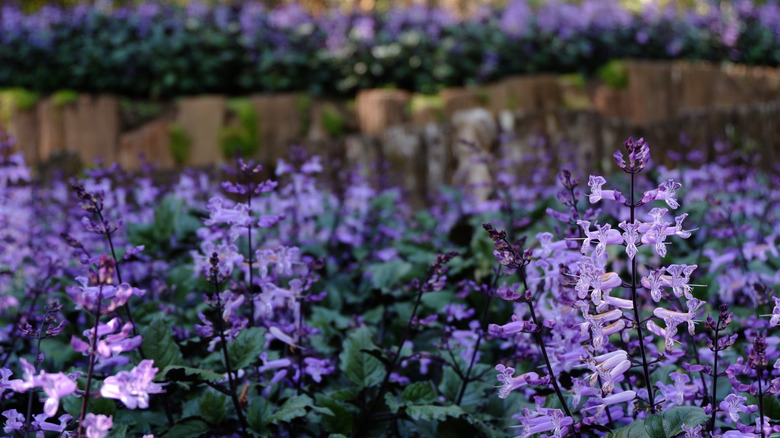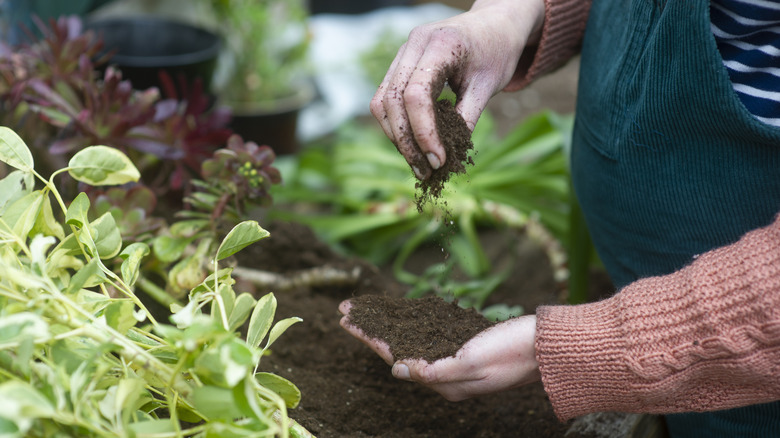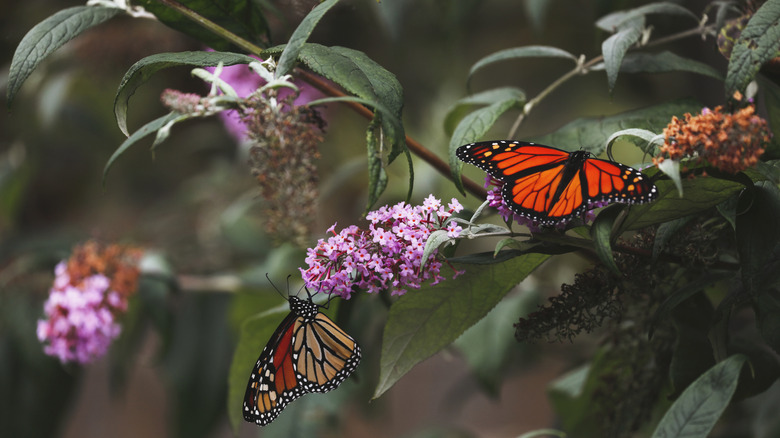The Fast-Growing Blue-Purple Flower That Attracts Gorgeous Butterflies To Gardens
Butterflies are more than just sets of pretty patterned wings and an easy at-home science project to teach kids about metamorphosis through insect rearing. These insects fit an important ecological niche as plant pollinators and a link in the natural food chain, which makes it all the worse to see news coming out about butterfly populations rapidly decreasing in recent years. If you want to help by creating a butterfly sanctuary in your backyard, it's as easy as growing the right kind of plants to attract and feed them. One such plant to consider is the blue spur flower (Plectranthus barbatus), also known as the Winslow spur.
You'll have to dedicate a lot of room in your garden for blue spurs, which quickly develop as shrubs that grow 6 to 8 feet on average — though this means growing them is one way to potentially get a lush and natural look on your landscaping borders. Part of a genus that's native to areas around Africa and India, blue spur shrubs are evergreen, even if their flowers tend to bloom during the fall and spring seasons, meaning they could become a permanent fixture of your garden after a modest early investment. Blue spurs also pair well with fellow butterfly host plants like the ground cover speckled spur (Plectranthus ciliatus) to create a pollinator paradise.
How to grow blue spur flowers in your garden
Plectranthus plants come in a wide variety, most of which require soil with good drainage to successfully flourish. Blue spur flowers don't need a lot of watering, overall, but do thrive in partial shade to full sunlight around USDA growing zones 9 through 11. The best places to grow Plectranthus barbatus in the United States will be on the western seaboard, as well as in southern regions around the Gulf of Mexico. Blue spur is a member of the mint family with homeopathic medicinal values, historically used to treat problems in the digestive tract. As with most herbs, it should grow best in lighter soils with high organic matter and a pH range of around 6.0 to 7.5.
These flowering shrubs are drought resistant, perfect for dealing with heat on the West Coast, and have hardy enough roots to survive temperatures as low as 20 degrees Fahrenheit – however, any substantive frosts will kill off the evergreen shrubbery. It's also worth watching out for soil-borne diseases, wilt complex, and nematode infestations that may impact the growth of blue spur flowers — especially notable given nematodes are a potential source of predation for even the most poisonous butterfly species. One solution could be trying to grow your blue spur flowers in different mediums such as coco peat.
Making a butterfly garden with blue spur flowers and other plants
If you really want to attract butterflies to your garden and give them spaces to naturally reproduce, you'll need more than just one strain of blue spur flowers. Flowers in the mint family are a good source of nectar, but a variety of different plants that bloom throughout the year will provide steady food sources (butterflies are most active in the mid-late-summer). Other plants that will fill your garden with a variety of butterflies include buckwheat, milkweed, mistletoe, asters, lavender, and far more. You'll also want plants with leaves that particularly attract caterpillars, making them less likely to chew through your entire garden. Good options include oak, cherry, and willow trees.
The most important thing is going to be discovering which butterfly attractors grow natively in your region. There are over 14,000 species of butterfly and moth in the United States alone, all of which will be unique in their preferences based on local environmental factors and evolution. If you do live within USDA growing zones 9 through 11, blue spur flowers are a great place to start with fast-growing plants for your butterfly garden — and, as a bonus, it's said that Plectranthus barbatus leaves can be an all-natural alternative to toilet paper, potentially bringing you just as many benefits as the butterflies.


